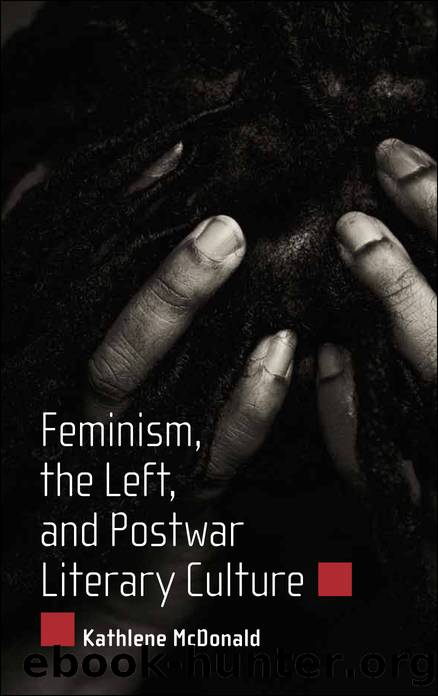Feminism, the Left, and Postwar Literary Culture by McDonald Kathlene;

Author:McDonald, Kathlene;
Language: eng
Format: epub
Publisher: University Press of Mississippi
Published: 2012-09-14T16:00:00+00:00
CHAPTER 4
Antiracism, Anticolonialism, and the Contradictory Left Feminism of Lorraine Hansberry
We are savage in our contradictions, we humans, Ah savage!
—Lorraine Hansberry, letter to a friend
When Lorraine Hansberry arrived in New York City in 1950, she moved into the same building as Claudia Jones and quickly became involved with a cadre of black women activists who were helping redefine the Left’s approach to the Woman Question in order to address the specific problems facing black women. These women included Jones; Thelma Dale, a leader in the Harlem Left and a founding member of the Congress of American Women; and Alice Childress, a militant playwright who helped start the Communist-led Sojourners for Truth and Justice. The various women in this Left feminist community emphasized the centrality of black women’s leadership in antiracist and labor movements and addressed such issues as workplace discrimination, the need to unionize domestic workers, and the importance of interracial unity. In the cultural realm, they argued for the need to present images of militant black women as alternatives to the stereotypical representations of black women in film and television shows.
Hansberry incorporated this Left feminist perspective in the articles that she wrote for Freedom and the lesbian journal The Ladder, as well as in many of her nonfiction writings and speeches. Her rather hefty FBI file, her history of activism, and her journalism illustrate the story of a woman unafraid to speak her mind, despite the consequences of McCarthyism. In her public persona, she never backed down from her Left stance. At first glance, though, her plays do not seem to reflect the Left feminist ideas she wrote about in her journal articles. But a careful reading of her dramatic works reveals the strategic ways in which she constructed representations of women who controlled the destiny of the play, thus emphasizing the key roles that black women have historically played in struggles against racism and colonialism.
Hansberry’s plays challenged the dominant domestic ideology of the age by focusing on black women’s roles in antiracist and anticolonial struggles and emphasizing black women’s strength. While her female characters do not take on leadership roles or fight for their own liberation as women, they still play important roles in struggles against both racism and colonialism by fostering men’s political development and helping them to tap into a tradition of black resistance. The three female characters in A Raisin in the Sun present inspirational alternatives to the dominant image of femininity. Mama fights for her family’s survival and struggles to teach her children the value of freedom and dignity. Beneatha challenges feminine standards through her decision to wear her hair “natural” and through her pursuit of a career rather than a husband. And although Ruth values her family, she considers an abortion because she and Walter cannot provide for another child. Other Hansberry plays feature similarly powerful black women: in The Drinking Gourd, a slave mother who arms her children and sends them off to freedom, and in Les Blancs, a black woman warrior who spurs a reluctant African man to join the armed insurgency against colonial rule.
Download
This site does not store any files on its server. We only index and link to content provided by other sites. Please contact the content providers to delete copyright contents if any and email us, we'll remove relevant links or contents immediately.
| Anthropology | Archaeology |
| Philosophy | Politics & Government |
| Social Sciences | Sociology |
| Women's Studies |
On the Front Line with the Women Who Fight Back by Stacey Dooley(4311)
The Lonely City by Olivia Laing(4120)
The Rules Do Not Apply by Ariel Levy(3905)
Bluets by Maggie Nelson(3709)
The Confidence Code by Katty Kay(3566)
Three Women by Lisa Taddeo(2920)
Inferior by Angela Saini(2831)
A Woman Makes a Plan by Maye Musk(2830)
Pledged by Alexandra Robbins(2790)
Not a Diet Book by James Smith(2726)
Confessions of a Video Vixen by Karrine Steffans(2674)
Nice Girls Don't Get the Corner Office by Lois P. Frankel(2594)
Wild Words from Wild Women by Stephens Autumn(2588)
Brave by Rose McGowan(2501)
The Girl in the Spider's Web: A Lisbeth Salander novel, continuing Stieg Larsson's Millennium Series by Lagercrantz David(2379)
The Clitoral Truth: The Secret World at Your Fingertips by Rebecca Chalker(2242)
Why I Am Not a Feminist by Jessa Crispin(2239)
Women & Power by Mary Beard(2224)
Women on Top by Nancy Friday(2121)
